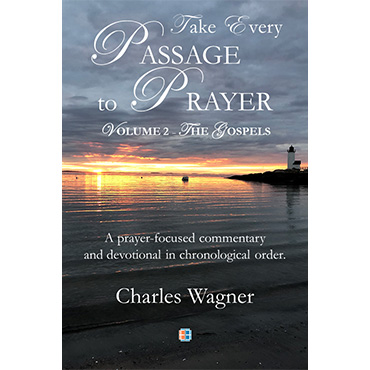The Gramazin Blog

Was Jesus a Real Person?
Take Every Passage to Prayer - Volume 2, The Gospels
Sunday May 19, 2024
Father, it is typical for an individual to be gullible and vulnerable to deception. Without You at the center of our hearts and minds, our judgement is distorted as well as our analysis. Searching for the truth takes substantial time, energy, and money. We would rather just have a good time. Therefore, it is much easier for us to accept the lies that are fire hosed at us every day by those who seek to deceive us. Those who seek to deceive us are often enemies of the four gospels. After listening to their perspectives for even a few moments, we begin to doubt the foundations of our faith, including the existence of Jesus of Nazareth. Father, I ask that You open up my eyes and ears to the truth. Give me discernment to detect lies and then to discard them. As I study Your Word, gird me with truths that will survive the storms of criticism and mockery sure to come my way because I believe that Jesus Christ is my Savior and Lord. Give me the power of persuasive logic and reason, grounded not in lies but in truth, so that You can open other people’s minds to the gospel of Jesus Christ through my ministry. Amen.
Father, before we begin our study of the four gospels, which detail the life, ministry, crucifixion, and resurrection of Jesus of Nazareth, I want to address those who say there was never an historical figure named Jesus. I would like to respond to those claims in three ways.
- Secular Historical Evidence. I cite the writings of 1st century secular historians who were not believers in the gospel of Jesus Christ. They clearly state that Jesus was a real person who caused trouble for the Romans.
Flavius Josephus, considered the greatest of 1st century Jewish historians, wrote this text in book 18, chapter 3, section 3 of his book, Antiquities of the Jews:
“At this time, there was a wise man who was called Jesus. His conduct was good and was known to be virtuous. And many people from among the Jews and the other nations became his disciples. Pilate condemned him to be crucified and to die. But those who had become his disciples did not abandon his discipleship. They reported that he had appeared to them three days after his crucifixion, and that he was a live; accordingly he was perhaps the Messiah, concerning whom the prophets have recounted wonders.”
In another passage, Josephus wrote:
“Festus was now dead, and Albinus was but upon the road; so he assembled the Sanhedrin of the judges, and brought before them the brother of Jesus, who was called Christ, whose name was James.”Publius Cornelius Tacitus was a Roman historian whose special focus was on the administrations of the Roman emperors in the 1st century. He wrote:
“Christus, the founder of the name, was put to death by Pontius Pilate, procurator of Judea in the reining of Tiberius.”In Sanhedrin 43a of The Babylonian Talmud, it states that Jesus was a sorcerer who was crucified on the eve of Passover.
Mara bar-Serapion, a 1st century philosopher, wrote a letter to his son of the same name. In it he spoke of the execution of the wise king of the Jews.
Pliny the Younger was a Roman governor. He wrote a letter to Emperor Trajan early in the 2nd century. He asked for advice about how to deal with Christians who sing hymns to Christ as if he was their God. Pliny complained that the Christians refused to give sacrifices to the Emperor.
- The Growth of Christianity
- Christianity grew so fast in the first and second centuries that by 300 AD 10% of the population of the Roman Empire, approximately 6 million people, were believers.
- Christianity had become so influential by 306 AD that Roman Emperor Constantine became a believer and ended the persecution of Christians in the Roman Empire.
- Christianity is growing at a 1.17% growth rate. It is estimated that there will be 3.33 billion people claiming to be Christians by 2050.
- There are more Christians in the world today than Muslims and Hindus. Christianity continues to outpace the growth of Islam. There are more Christians in the world today than agnostics, Buddhists, Chinese folk religion adherents, atheists, Sikhs, and Jews combined.
Father, do people really believe that Christianity could have grown so much in the last 2,000 years if it was based on a fictitious character? Do people really think the disciples would spread the gospel throughout the Mediterranean, willing to lose their lives for their mission, if they had “photoshopped” Jesus onto the pages of history? How many residents of Jerusalem or Galilee, supposed contemporaries of Jesus, would have believed in Jesus when they could not find any record of His existence? “I never saw him in Nazareth. Did you? No. I didn’t either. There wasn’t a crucifixion at Passover that year. I was there. Everything was normal. I’m not going to believe this nonsense.” Father, the magnitude of the growth and the influence of Christianity is not conceivable if Jesus was a fictitious character.
- The Integrity of the New Testament. There are approximately 5,700 handwritten ancient Greek manuscripts of the New Testament as well as an estimated 9,000 manuscripts in other languages. Many of these 15,000 manuscripts are complete Bibles. Many of these manuscripts date back to the 1st and 2nd centuries. The earliest manuscript containing the full gospels dates back to 250 AD. The earliest entire New Testament dates back to 325 AD. No other ancient writing comes close in the number of ancient manuscripts. Early church fathers such as Justin Martyr, Irenaeus, Clement of Alexandria, Origen, and Tertullian quoted the New Testament over 36,000 times in their writings, enabling the complete reconstruction of all but 11 verses of the New Testament. It has been estimated that, when comparing the ancient manuscripts and writings to the current copies of the New Testament, there is a 98.33% purity of text. In other words, today’s New Testament is practically identical to the New Testament of the third century. It is believed that most, if not all, of the New Testament was written by 70 AD, within forty years of Jesus’ death. If Jesus was a fictitious character, there were thousands of people alive during those forty years who could have “fact checked” the gospel accounts and shut down Christianity before it ever got started. We have plenty of evidence in the 21st century that the written story of the life and teachings of Jesus Christ were carefully detailed, preserved, and copied by His contemporaries because they believed His life was incredibly important and relevant to the general population. This would not have been true if He was a fictitious character.
Father, I believe that Jesus was a real man, an historical figure, who walked this earth between 4 BC and 29 AD. It is from this perspective that I now study who He was and what His purpose was on earth. Amen.
Footnotes
4. Sources: I Don’t Have Enough Faith to Be An Atheist, by Norman L. Geisler and Frank Turek.; article entitled “5 Secular, non-biblical authors who verify Jesus’ life and ministry” published on June 22, 2017 on the website www.dowym.com;
5. The article entitled “The Early Growth of Christianity” on the Bart Ehrman Blog. article entitled, “The Growth of Christianity In The First Centuries” by Jeff Kenon.
6. CBN News, article published February 4, 2022 entitled, “Global Growth of Christianity Outpaces Atheists, Charismatic Churches Lead the Way”.
7. The article entitled, “Statistics and Forecasts for World Religions: 1800-2025”, on the website www.christianityinview.com.
8. Source for the data in this paragraph: I Don’t Have Enough Faith to Be an Atheist, by Norman L. Geisler and Frank Turek.
9. None of the 27 New Testament books look back at the destruction of Jerusalem in 70 AD from a historical perspective. This fact “screams” at us that these books were written before this year.







